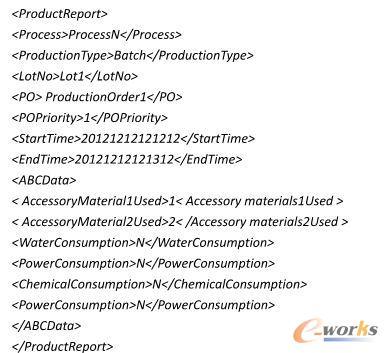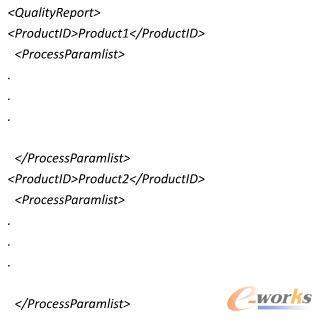Writer‘s note:
There's a very interesting article http://www.syntropicfactory.info/node/3799 wrote by Mr. Jean Vielle, who's an expert in this area. He explained the B2MML use cases in this post. It's after I wrote my article then started to look for some exsisiting solutions to the topic then I saw this. It explained a solution in a more structured approach.
---------------------------------------------------------------------------------------------------------------------------------------------------------------------------------------------------------------
With decades of development, there’re currently a lot of available IT solutions for different usage.
Each solution is responsible to carry out the routine tasks of the stakeholders.
We can see, in a manufacturing enterprise, ERP vendors are focusing on setting up the standard working flow the help the whole enterprise to carry out the routine tasks. MES/CIMS vendors are helping customers on automating the execution of production plans and optimizing the total yield/quality. WMS/WIP inventory management system helps the logistic department to manage the materials to make sure the transportation and delivery of materials to the production line in right time. APS acquires the process cycles to help make computation under different restrictions and need to monitor the buffer thresholds from production line then give feedback decision to production line based on DBR technique. Facility system monitors the purified water and precious chemicals flows. There’re redundancies over the data collection for those different IT application systems, and always there’s case that different systems are getting different data over the same subject, thus different decisions are made based on different data inputs. Those different IT applications create isolated islands.
How to change this situation?
There’re already answers and many vendors are doing this. A lot of idea -- SOA, ESB,EA and BPM.
My background is mainly in CIMS/MES area. So the main goal of writing this article is try to analyze how we can improve MES design/modeling and thus can helps MES and other diverse IT solutions in manufacturing enterprise to co-work to achieve the desired function and features which users of the software solutions request and reach the best efficiency of information usage (The customer might like to have a total solution provider so life would be much easier then. But actually there’s no vendor in the market who can cover all the different aspect of IT solutions because there’s enormous know-how in each individual applications. So let’s go back to real life).
I think the following 2 principles are important to follow:
1) All the information flows inside and between different system should be as detailed as possible (Because it’s necessary to calculated time/cost/performance individually)!
2) Whichever application system gets the raw data, should it be responsible for summarizing then sharing the data with other application systems.( SOA)
Normally following items are defined in MES:
Product à Product general information.
Routes à The process flows defined for each different product.
Process à The process that the process equipment can handle to produce the product.
Process Equipment à Execute certain recipe to change the physical form or chemical components of the material.
Recipe à Recipe which belongs to each equipment, is dedicated for certain process.
Production orders à Number of product needs to be produced according to MTS plan or based on sales order.
Different products lead to different production routes, different routes can have different process flows, each process step can have different machine to perform the process, and each process machine can have many different process recipes dedicated for different processes (the equipments should keeps the basic information for the machine to execute, and the different recipes information can be exchanged with MES, but it’s MES’s responsibility to make sure the correct mapping of different recipes with processes).
And follow information are collected into MES via machine integration or manual input:
Equipment parameters à process values, chemical flow rates, power rates.
Equipment status à SEMI E10 status, OEEs
Alarms à alarms happened in equipments.
Production lots à A production order will be distributed into many lots, the minimum lot is for the transportation system/carrier system.
Production results à quality(OK/NG or Grade A,B,C),quantity and total yield.
You shall still remember the 2 principles I mentioned above.
MES is able to calculate out the detailed cycle time of any equipment for each process.
MES is also able to calculate out the buffer counts of each process/equipment, thus, the time needed to produce those materials based on cycle time.
MES is able to tell the time period of material transportation between different process steps/equipment.
MES is able to manage the priority of production orders and then tell the transportation system to move the material of top priority to process machines.
Based on the select equipment recipe and the real time product production process, MES is able to calculate the accessory materials usage.
APS needs detailed information of the constraints to make the calculation. From MES, it can get the detailed cycle, WIPs at each process steps and the time needed to produce those materials.
So when defining the process and equipment in MES, we can add following attributes:
1) General WIP information Which production order it belongs to.
2) Start-end of each cycle According to different production type, different model need to be realized, and possible measurement channels should be defined to capture the start-end signal/data. Equipment with multi chambers also should be taken into consideration. How to model over the cycles.
3) WIP priority change flag Possible or impossible. This I means if the WIP can be held for process, it’s for material balance or in case of production order priority change. Some special process might have Q-times, that product must be produced after/before certain of time period. If this flag is possible, it means the WIP can be held at any time for any time period. If it’s impossible, there should be time period added, ‘+‘ or ‘-‘. MES system can report those information and Drum-Buffer-Rope control should be realized in these ‘impossible’ process steps to alert the previous process step.
4) Accessory materials and buffers Accessories used in the process should be defined, kilos of pastes, numbers of switches etc.,(not coming from facility systems directoly) and the usage for each recipe should be defined. Scrap report function of accessory material also should be provided. So MES can automatically calculated the used accessory materials and double check with WMS/WIP inventory/Kanban.
5) WIP buffers If have, counts needs to be defined. It’s for material balance and calculation of APS. DBR control also need to be realized in these process steps which have certain buffer thresholds. This information also needs to be shared with WMS/WIP inventory system/kanban.
6) ABC Channel For cost calculation, activity based costing method, Should define the materials/Chemical/PowerConsumption used for the process, for chemical/water/electricity power, the MFCs/power meter data can be collected via machine integration. MES should assign the detail channel and make calculations. For accessory materials used in this process, it should be also defined.
7) Production type of each process By piece/batch/inline, if it’s pieces/batch, all the information should be sent out after process end to each piece/batch. If it’s inline process, the report should be sent in defined time period.
Let’s use XML to describe the information sending out from MES to other solution systems(The real information flow might be transferred by some middle ware or use the ESB structure, it’s out of the scope of this article).
After a product lot (piece/batch type production) has been processed at certain process step, or after certain period of time(inline type production),MES should create such report:
Also there should be report about the remaining WIPs at this process machine/step.
There should be accessory material report
There also should be report for quality management systems
For each product/lot, the ERP system will get the report of over all the consumption in each process. It’s enough data for ABC. APS system gets the detailed cycle information and estimated time for remaining WIPs. The WMS system will know the remaining WIP inventory information and make decision of refill the buffer or not(Kanban system same).
Let’s assume a case: The sales team received an order from customer and they need feedback from production, if the production plan can meet the delivery time.
APS’s getting the WIP information from each process step in real-time, and MES also reported the needed process time for each WIP, and the priority of it. APS also knows if certain WIPs can be delayed or postponed. It can be calculated out if the PO is accepted, is it possible to meet the delivery schedule (The delivery schedule of other order should also be met). APS knows the accessory material at WIP inventory for each process step (Also the WMS inventory), so it will be possible to calculate out if the accessory material is enough for the new production order, if not enough material, it will check the lead time for purchasing that material.
If the result from APS system is -- it’s ok to accept the new purchase order and it won’t affect the delivery of current sales orders. So a new production order will be created and synchronized with MES, it’s maybe necessary that all WIPs belongs to other production order shouldn’t occupy the process machines while the WIP of new PO arrives (There’re a lot of ways of doing this prioritize, one example is the railway control system, slower trains should wait at the station for faster trains, because there’s only 1 rail available for same direction. This discussion is out of the scope of this article, you can find out the solution in real projects).
These are just one way information flow from MES to other system.
I don’t want to expand this article to a book because it’s just a little pre-discussion. So these are just one way information flow from MES to other system. For the other direction of information flow, it could be defined in the same way.
It’s not necessary for each company to have all the different IT application systems and it’s the real situation. What you can improve is, try to figure out the interconnections between the different solution systems and the possible business process of the company. You can find out how to exchange data between the different system to achieve better efficiency and higher value.
It’s predictable that, without revolutionary change, it will remain the same that many software vendors will provide diverse software solutions which are highly matured customers. The isolated islands will always needs to connected. So I think ideas of BPM/ESB/SOA will be more and more important.
The previous analysis didn’t take account of the realization of ESB or other middle ware solutions.
The previous didn’t take account of the difference between discrete and flow industry.
The previous mentioned features of MES not realized in any of my previous experience.
There’re a lot of authors to thank, thus in order to save the effort of listing the references of all the books, so no direct quote (except terminologies) is made out of those books. I just write this article all in my own words.
I would like to exchange ideas with all readers of this article. Your expertise in previous mentioned solution areas or enterprise management is appreciated. Any feedback, I can be reached by email sideways.yu@gmail.com



























 1164
1164

 被折叠的 条评论
为什么被折叠?
被折叠的 条评论
为什么被折叠?








